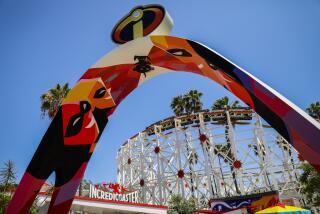Students Turn Amusement Park Into Laboratory : Physics Theory Has Its Ups and Downs
- Share via
It used to be that young people went to the amusement park just for thrills.
But a clever physics teacher has devised a way to make students contemplate what acceleration is at the same time they enjoy what it does.
About 3,000 Southern California students tried it Sunday, which was High School Physics Day at Magic Mountain in Valencia.
The event is the brainchild of John McGehee of Rolling Hills High School in Rolling Hills Estates.
“Too much theory is taught in the classroom,” McGehee said. His idea was to turn the students loose in a living physics laboratory and make them understand it.
Using only simple instruments made at home and their own ingenuity, the students had to find out things like the rate of acceleration of the Colossus roller coaster and the amount of centripetal force required to keep a body from being ejected from the Revolution, another roller coaster that features a loop.
So, instead of screaming with their arms held up in the air like the other teen-agers in the park, the physics students held up odd-looking devices and stared at them intently, trying to take readings.
One such device was a simple protractor with a weight suspended on a string from its center.
As the student holding the protractor was accelerated on a ride, the weight tried to stay behind because of inertia. Another student then attempted to read the angle of the string and write it down.
Kennedy High School students Kyong Song and Angel Lee used another device hoping to learn how many gravitational forces are developed by the Buccaneer.
That ride is a giant pirate ship that swings back and forth so high that the hull of the ship is sitting vertical.
While everyone else was screaming, Kyong and Angel held up a small spring scale to which they had attached a plastic box full of fishing weights. They were trying to read how much more the weights weighed at the bottom of the arc.
They got off the ride giggling.
“We found out that it’s hard to read this thing,” Angel said.
It proved even harder on the Colossus.
But then, that’s the idea, McGehee said.
“Life is not simple,” he said. “That’s physics.”
Another kind of problem was to determine the speed of the Revolution as it enters the loop.
That meant measuring how far the car dropped.
The method was triangulation. The students taped straws to the top of their protractors. One student would sight down the straw, aiming at the top of the structure, while another would read off the angle formed by the weighted string.
Then they would march off a few paces, using the stride to estimate the distance they walked, and take another reading. Ideally, the base of the triangle would be flat.
But the terrain wasn’t always flat, as Zeev Raunoy discovered. Raunoy, a physics teacher, was assisting his son, Avinoam.
“I don’t think you should count on our calculations,” Raunoy told several other students who drifted up to study his method. “According to us, this is 100 meters tall.” That was much too tall.
Most of the questions were posed simply for the pleasure of solving them.
But several hundred of the students competed in what was called the Physics Olympics.
One event was to float as many pennies as possible on a barge made of a small piece of aluminum foil.
For the architecturally minded, the challenge was to build the tallest tower out of a single 8- by 10-inch sheet of paper and a short piece of tape.
Van Nuys High School students Anna Luisa Padilla, Susan Ursua and Jose Santiago won the contest.
They cut the paper into strips each six centimeters wide and taped those into triangular girder sections. Each girder section was the height of the piece of paper and the sections grew progressively narrower up the tower.
Spire on Top
They added a spire to the top, made of a single strip of folded paper. It reached a height of 2 meters, 49 centimeters.
For the metrically illiterate, that’s about 8 feet, 2 inches. And it stood more than 15 seconds.
“We’ve been practicing once a week since January,” Susan said.
“We were determined to win,” teammate Anna said.
Later in the day, students who were not so adept at the practical side of physics tried to find the answers to a set of problems called Fermi questions.
The form of questioning is named after physicist Enrico Fermi, the first man to split the atom. A Fermi question deals with things that cannot be measured easily.
An example is “How many words are in your physics book?”
Answers Estimated
The answers are estimated by using powers of 10, McGehee said. For example, the number of words on a page would be counted as 1,000 if that were more likely than 100 or 10,000.
Sometimes this form of questioning called upon scientific detachment.
One question was, “If you read an entire calculus book every hour of your life, how many cubic meters would be needed to store them all when you died?”
To find the answer, the students were supposed to estimate their own lifespans as 100 years, since that would be closer than either 10 or 1,000.
And that made the physics students different in one way from the average teen-ager at Magic Mountain on Sunday. Most of them acted as if they thought they were going to live forever.
More to Read
Sign up for Essential California
The most important California stories and recommendations in your inbox every morning.
You may occasionally receive promotional content from the Los Angeles Times.














